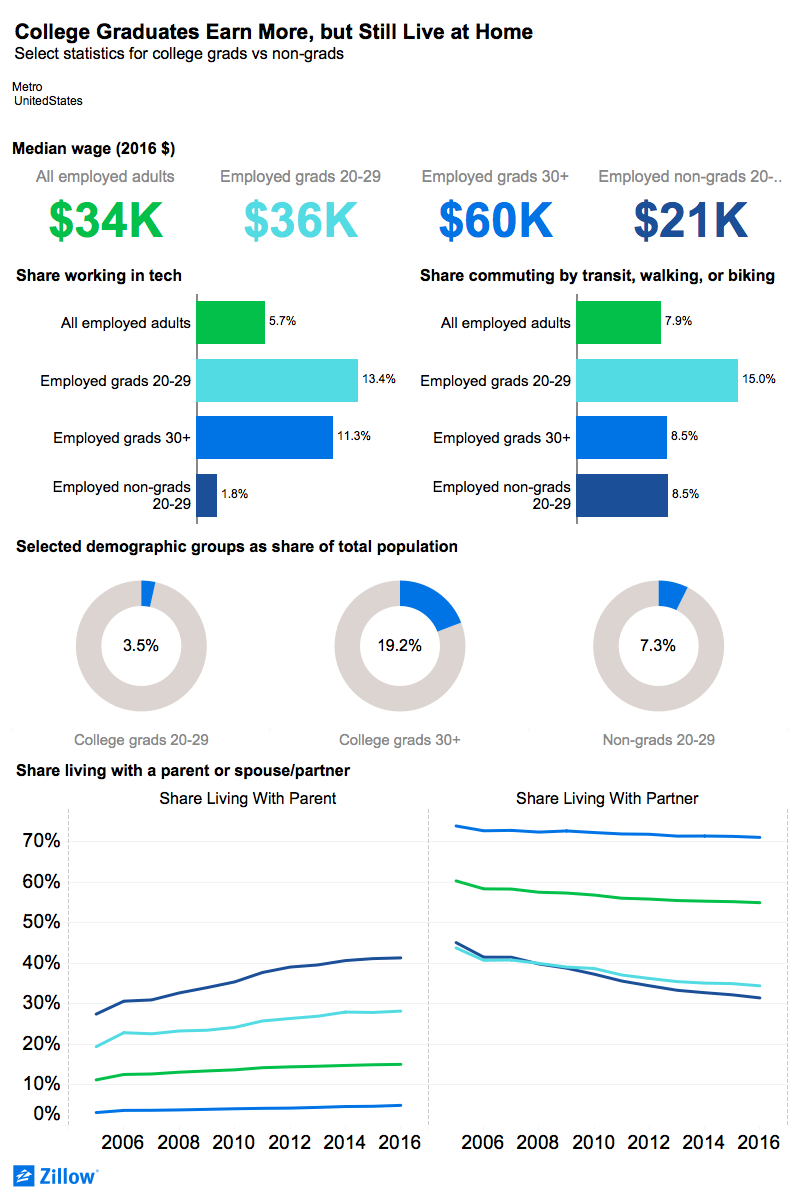- The number of college-educated twenty-somethings has increased by 75 percent or more since 2005 in the coastal tech hubs of San Jose, San Francisco and Seattle, in addition to more-affordable southern markets including Houston, Orlando and Charlotte.
- San Jose, San Francisco and Seattle also have the highest shares of young college graduates working in tech. But Midwestern manufacturing cities including Detroit, Kansas City, and Columbus also have perhaps surprisingly large shares of young tech workers.
- The median young, college-educated person earns more than the median American worker, but the inflation-adjusted wage growth of recent grads has been slightly worse (-2.4 percent) since 2005.
- Despite relatively high wages, more than a quarter of young college graduates live with a parent, up from nineteen percent before the recession.
New college grads have flocked to West Coast tech hubs over the past decade-plus, attracted by abundant opportunity in the growing tech sector and the healthy salaries it provides. But as those markets rapidly become less affordable, recent data hints at a changing tide – and suggests rising housing costs nationwide are putting a squeeze on grads’ ability to strike out on their own.
As the college class of 2018 decides where to live and work, the characteristics of younger, highly-educated millennials is sparking speculation among both employers and advertisers. A Zillow analysis of Census data on young college graduates[1] paints a nuanced picture of where they are likely to live and work, and how that has changed over time.
Between 2005 and 2016, the population of 20-somethings with a college degree exploded in the main West Coast tech centers of San Jose (up 103.7%), San Francisco (+93.3%), and Seattle (+82.3%). But more-affordable markets across the Southeast and Southwest have also seen large influxes of college-educated twenty-somethings over the past decade or so, including Houston (+80.4%), Orlando (+76.3%), and Charlotte (+75.5%).
Several markets that offer the highest earnings potential for college graduates also have the largest shares working in tech.[2] In San Jose, 39.7 percent of young, college-educated workers are employed in the tech industry. In Seattle, that share is 24 percent and in San Francisco, 22.7 percent. The 10 markets with the greatest share of young college graduates working in tech also has healthy representation from the Midwest. In Detroit, 17.9 percent of recent college graduates work in tech-related jobs, likely due to the city’s burgeoning startup scene and the large number of engineers employed by local automakers. Similarly, Kansas City and Columbus employ 16.8 percent and 16.7 percent, respectively, of their young college grads in technical jobs, often in engineering roles for manufacturing and technology companies.
Young graduates’ motivations for flocking to these cities is no mystery: Among large metros, San Jose, San Francisco, and Houston offer the highest median wages for employed recent grads at $60,000, $54,000, and $45,000, respectively. These numbers contrast dramatically with those of twenty-somethings without college degrees; in those same cities, grads’ less-educated peers make just $23,000, $25,000, and $20,000, respectively.
Use the tool below to explore some key statistics on recent college graduates, and how they compare to their older and/or less-educated peers nationwide and in a number of large markets.
Parents as Roommates
Despite the enormous income advantage of twenty-somethings who hold college degrees, they have not been spared the wage growth woes of the rest of the country. Nationally, the typical employed adult made 1.2 percent less in 2016 than they did in 2005; the median recent grad fared even worse, making 2.4 percent less.[3] This phenomenon is fairly widespread: in 23 of the largest 35 metros, young grads today make less than their pre-recession counterparts did.
And even as wage growth stagnates, rents and homes values nationwide keep going up – to say nothing of mounting student debt. This might help explain why more than a quarter (28.2 percent) of U.S. twenty-somethings with college degrees live with a parent, up 8.8 percentage points in a little more than a decade.
This trend toward rooming with mom and dad holds across all 35 major metropolitan areas, but it’s especially dramatic in places that were particularly affected by the housing bubble and subsequent crash. In Riverside, Calif., for example, a majority (51.5 percent) of young grads live at home, a startling 24.3 percentage point increase from the pre-recession era. Similarly, Las Vegas saw a 25.5 percentage point jump (to 38.6 percent) in the share of recent college grads living with a parent between 2005 and 2016. In seven other major metros, at least one-third of twenty-somethings with college degrees live at home, including in the hard-hit Rust Belt cities of Detroit and Chicago.
When the housing bubble was at its height around 2005, it was much easier to get a loan, and the building boom meant there were many more homes available to choose from. For young college graduates at the time, moving out was a more manageable option. Today, tighter lending standards, high home prices and constrained inventory make breaking into the home-buying market more difficult for recent graduates.
And as if we needed to prove the point that living with one’s parents isn’t exactly sexy, the parent-as-roommate propensity dovetails neatly with an overall decline in the share of college-educated twenty-somethings who live with a romantic partner. Nationally, one-third (34.5 percent) of young graduates reported living with a partner in 2016, down 9.4 percentage points from 2005. While recent grads are more likely to live with a partner in Midwestern locales like Kansas City (45.4 percent) rather than in coastal cities such as New York (22.3 percent), the share has declined in every major metropolitan area over the past decade. This trend may be partially attributed to young people choosing to delay marriage outright, but another likely cause is that many twenty-somethings today simply cannot afford to move out of their parents’ homes.
Tough Trade-Offs
Younger, highly-educated millennials are often depicted as awash in happy hours and brunches, with gleaming apartments in the downtown cores of coastal cities, and in a few key ways these characterizations hold some truth. Young college graduates earn more than the median American worker (and dramatically more than their non-college-educated counterparts), they make up a growing share of urban populations and they are disproportionately likely to work in tech.
On the other hand, inflation-adjusted wages of recent graduates have declined since 2005, beyond the broader national stagnation, and over a quarter of twenty-something with college degrees live with their parents, a share that has only increased over time. As the cost of living continues to rise against flat wages, and as these graduates must face student loan repayment, brunches and downtown lofts may be increasingly out of reach for many.
[1] Steven Ruggles, Katie Genadek, Ronald Goeken, Josiah Grover, and Matthew Sobek. Integrated Public Use Microdata Series: Version 7.0 [dataset]. Minneapolis: University of Minnesota, 2017. https://doi.org/10.18128/D010.V7.0.
[2] Technology occupations are defined here to include Computer and Mathematical Occupations; Architecture and Engineering Occupations; and Life, Physical, and Social Science Occupations as categorized by the American Community Survey.
[3] After adjusting for inflation (2016 USD)

